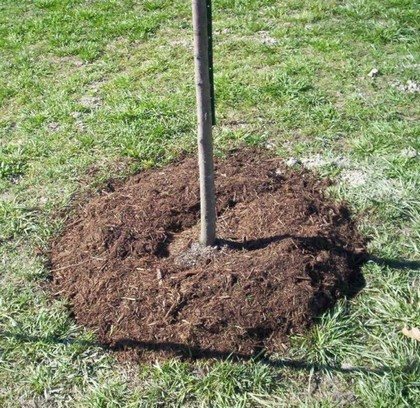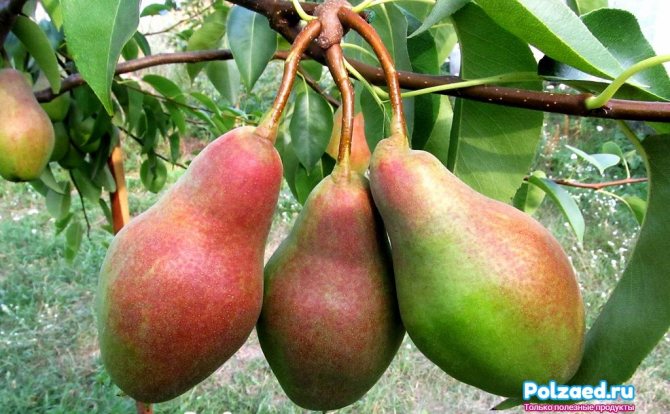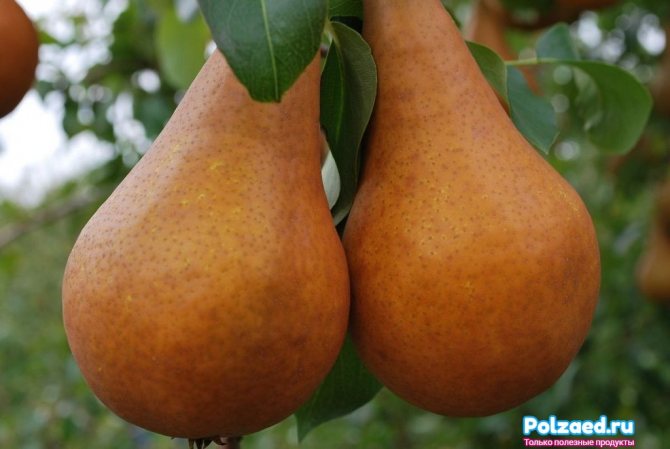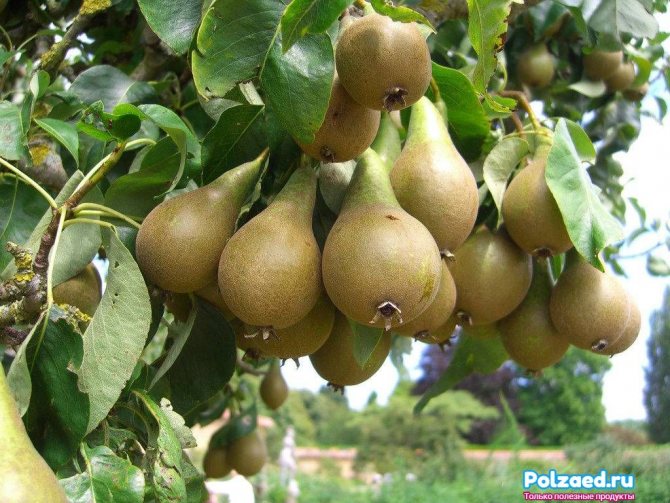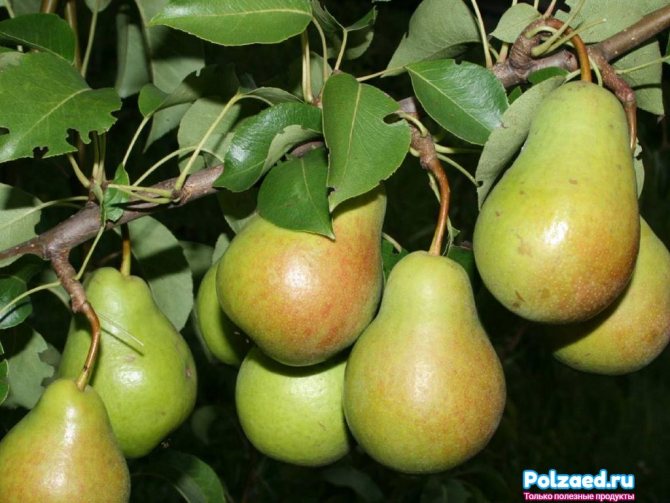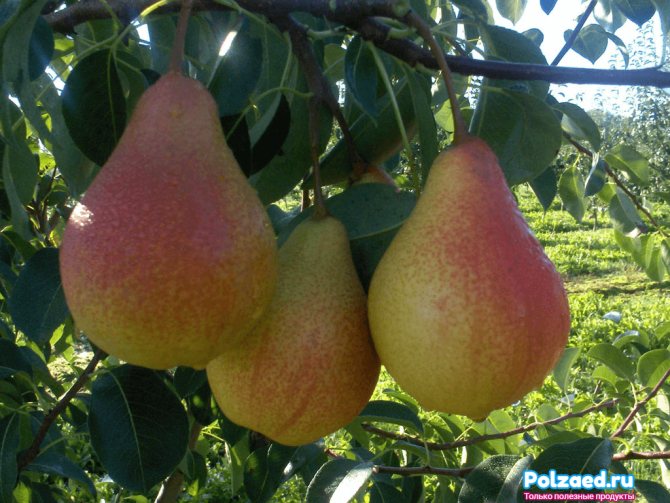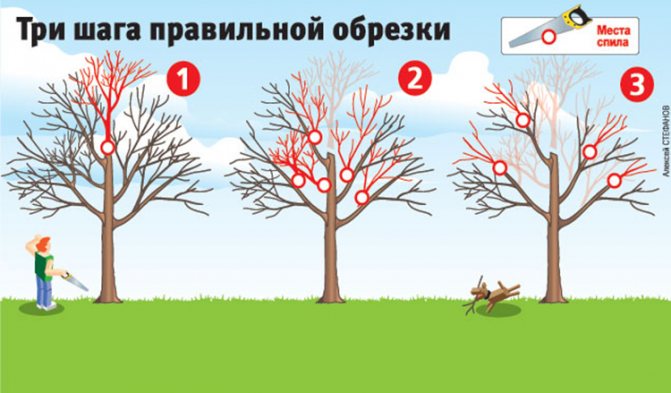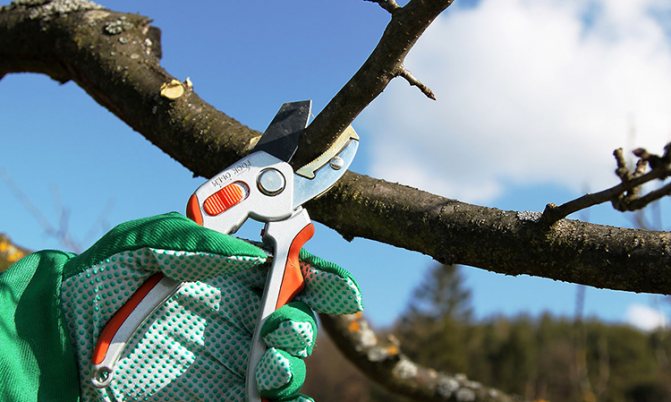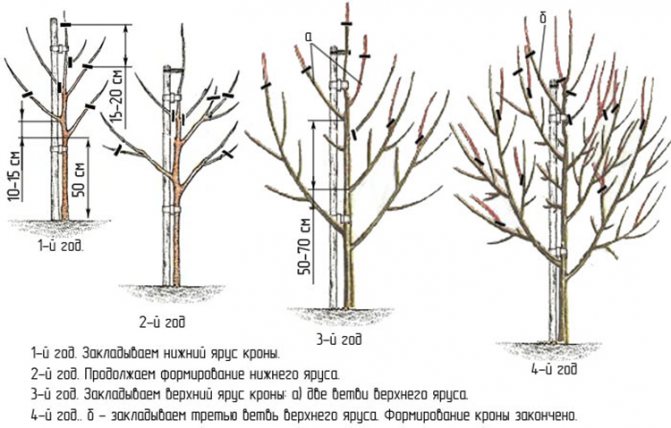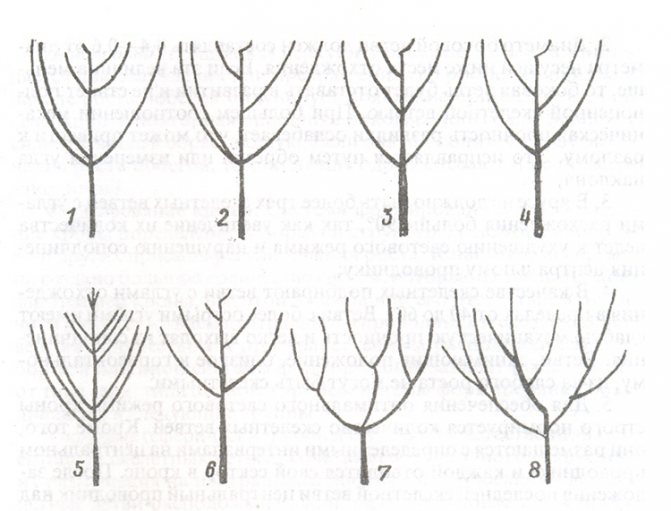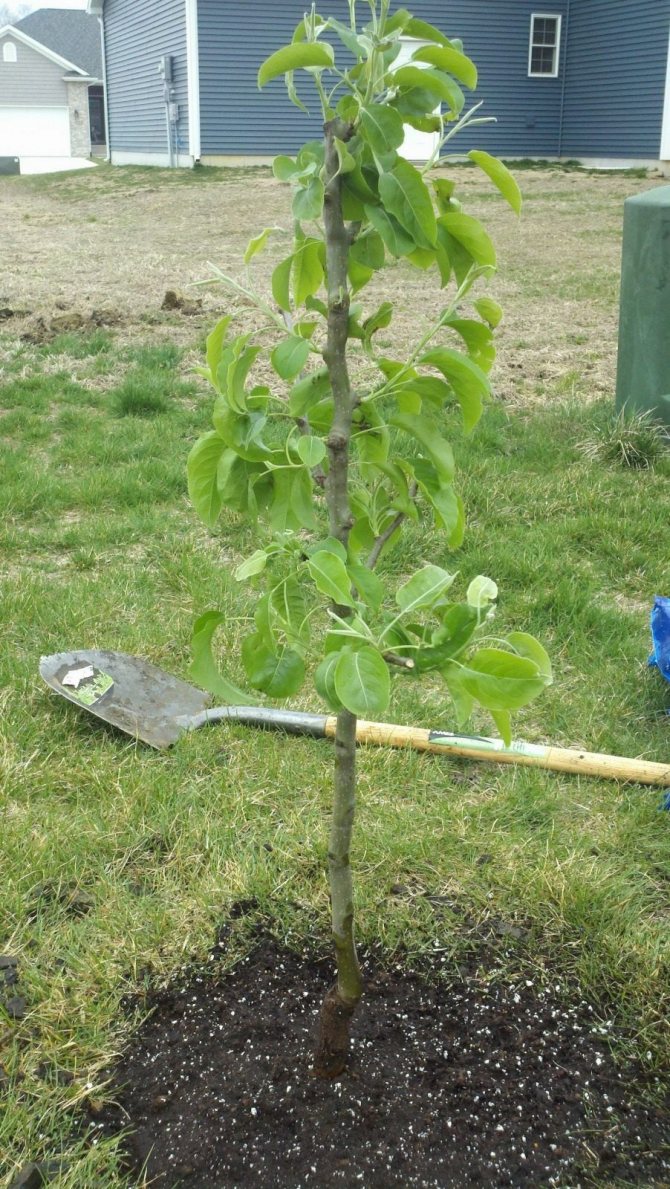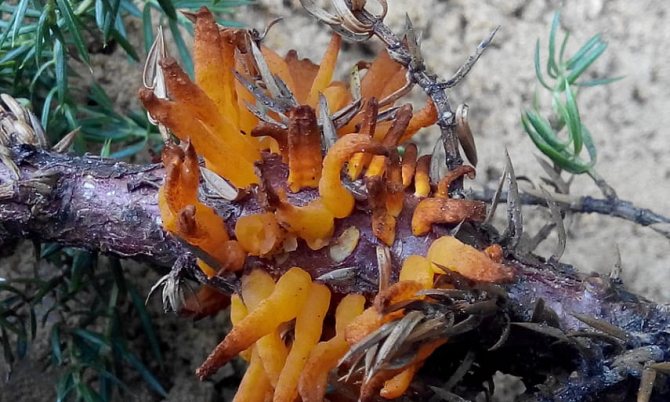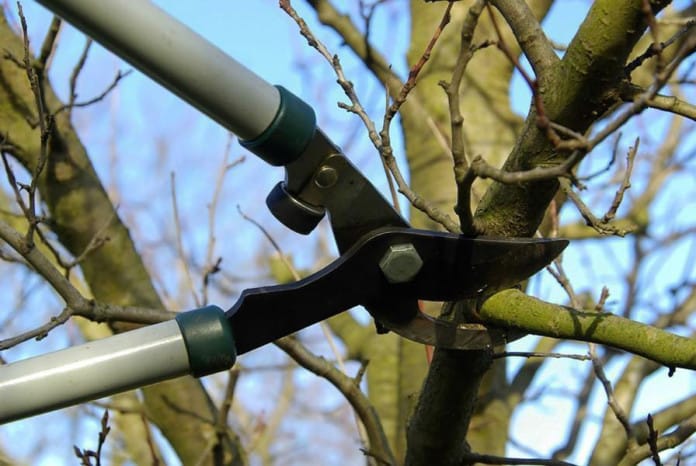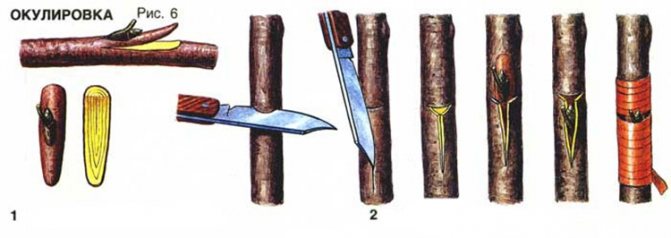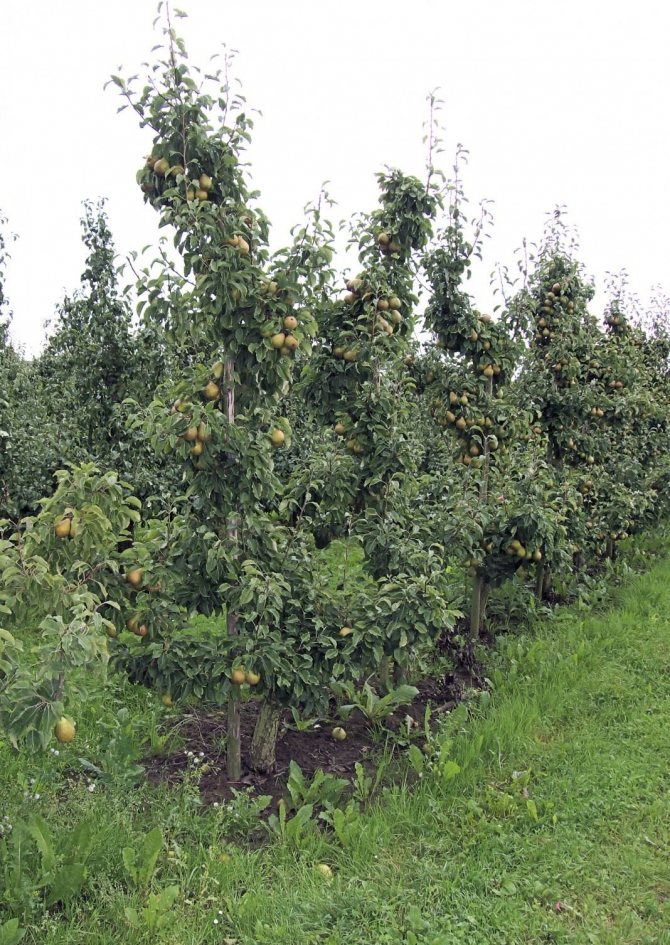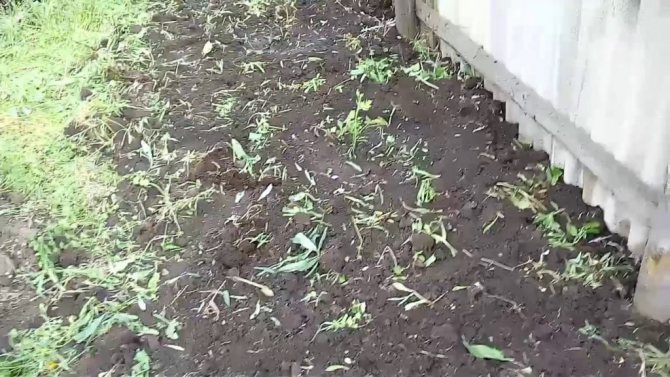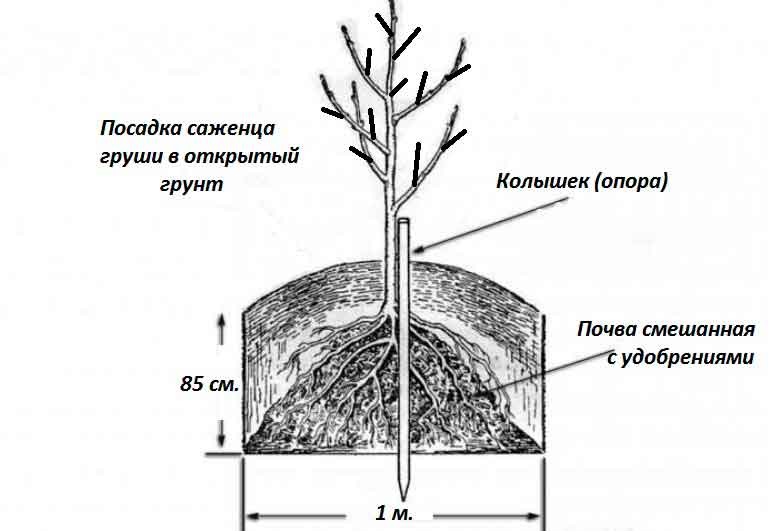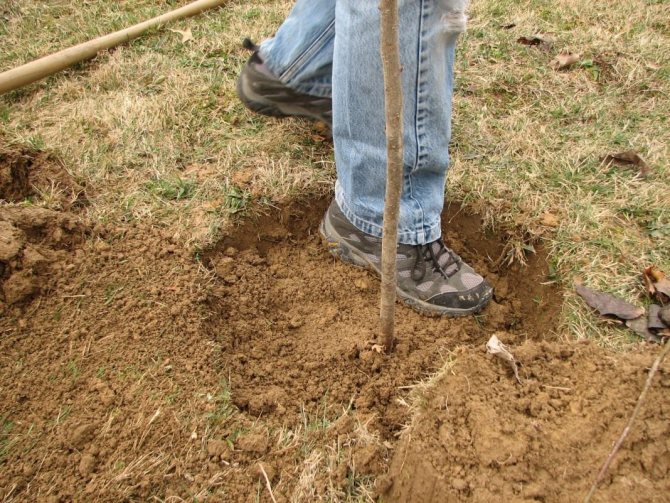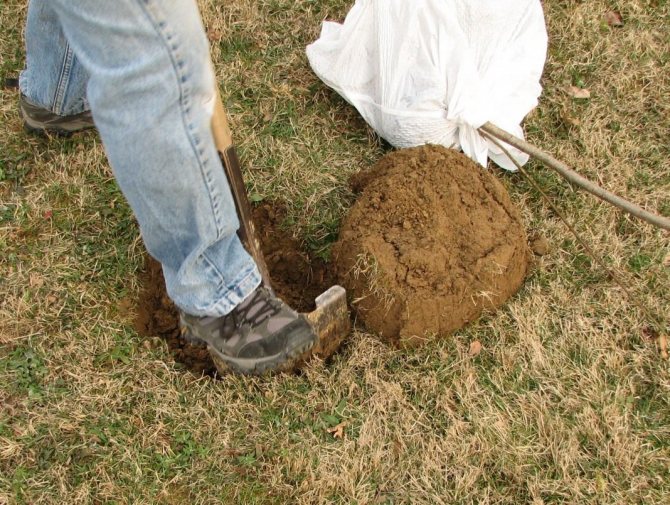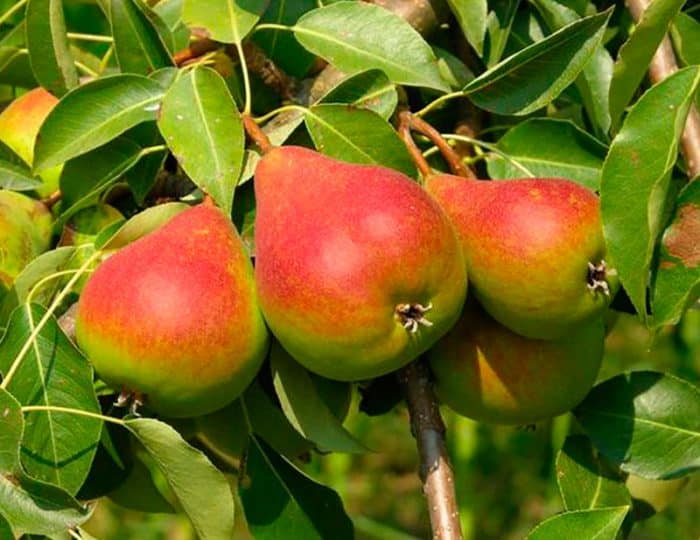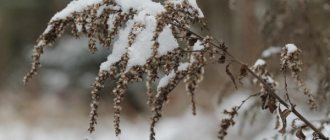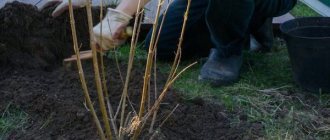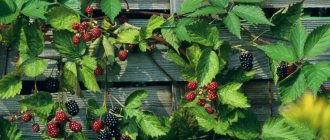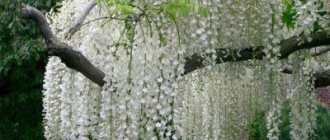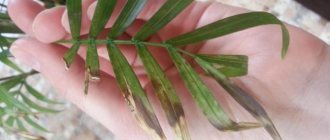The pear as a horticultural crop is in the top five horticultural fruit trees. Pears are not just delicious fruits, but they also have a wonderful (special) property. Allergy sufferers can safely eat them both fresh and processed. The perfect combination of grainy pulp with a pleasant aroma gives pears an exquisite taste. The amazing qualities of the pear fruit are revealed gradually. The entire aromatic and flavorful bouquet of the fruit appears only after ripening and "maturing". Pears are called a tasty medicine for the urinary system. It is the only crop that contains arbutin. A substance required for the treatment of the bladder and kidneys. Pear fruits contain a large list of trace elements and substances, the combination of which counteracts the deposition of salts in the liver and kidneys. Chlorogenic acids strengthen the capillaries and help remove bile from the body.
Pears on a branch
In general, the pear is the crop that should be grown in every country house. It is not difficult to grow it. The pear is not capricious, although it has features that must be taken into account when selecting varieties, growing and formative pruning. Recently bred varieties and hybrids of pears have made it possible to advance the area of cultivation in the northern regions of Russia.
Autumn pear care
Ancient poets called this tree a gift from the gods. Today she is called the queen of the garden. It is difficult to disagree with this. The pear is one of the most desirable fruit trees for most gardeners. Several thousand varieties of this culture, to date, have been bred by scientists - breeders. There are those who are not afraid of the harsh climate of Siberia and the Urals. Even the poor sandy and loamy soils of St. Petersburg and the Moscow region are not a hindrance for a real gardener, amateur and connoisseur.
A juicy, aromatic pear is loved for its taste and the abundance of vitamins that it is so rich in. But not everyone succeeds in growing this tree in their garden. She requires constant attention and competent care. It is especially important to properly prepare the tree for wintering.
Spring preventive treatment
With the onset of spring, every gardener has a lot of trouble in the front garden. After all, you need to have time to prepare the trees for the growing season, so that the whole family can enjoy a rich harvest from their own garden. So, where to start preventive work in the front garden in order to protect the future harvest from diseases and pests:
- They start processing as soon as all the snow has left the garden.
- Spraying pears in spring, as well as apple trees in spring, is carried out completely, they process the tree trunk, crown, and also the near-trunk zone.
- During processing, special attention is paid to places where there are splits and cracks in the bark. The fact is that it is in such places that parasites and fungal spores winter.
- Before spraying, you need to clean the tree from lichen and moss using a wooden scraper, since pupae and larvae of pests are most often located under them.
- In order for the treatment to give a result, use only fresh solution.
- To protect the garden, do the treatment three times per season: in March, before the pear starts flowering, and after flowering.
In addition to processing, the pear needs spring sanitary pruning, which is performed even before the sap flow begins.
Such manipulation is carried out as follows:
- thinning the crown to prevent thickening;
- remove all frozen, defective and broken branches;
- all old branches that have become less fruitful are excised.
In the fight against diseases and parasites, pruning is not the last place. Indeed, it is often in the defective branches that whole colonies of insect parasites are concentrated.
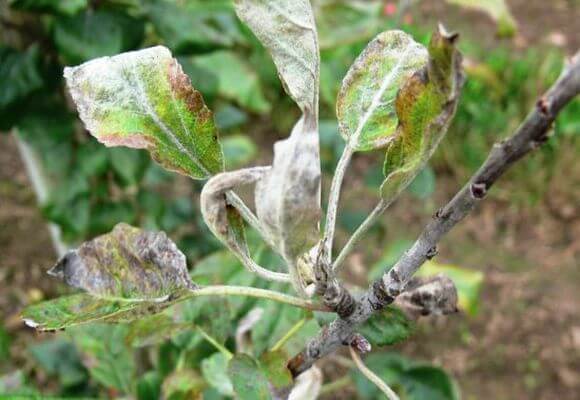
Cleaning the garden


Cooking pears for winter begins in mid-August. Autumn cleaning of the garden is simple, but very demanding work. Garbage that accumulates in the garden during the spring and summer period can become an attractive habitat for animal pests and pathogenic microflora.
- You need to start the August garden cleaning with the circles near the trunk. There, most often, many fallen leaves and fruits accumulate - a habitat and a favorable environment for the reproduction of various pests and tree diseases. All this should be removed.
- Next, we proceed to inspect the pear tree. All rotten fruits, leaves that continue to be on the branches, must be carefully removed. Do not knock them down with a stick. Such actions can seriously damage the branches, and this can cause the pear to become infected with such a dangerous fungal disease as scab. It is better to remove old fruits with a special elongated secateurs.
- Foliage and "rotten" are carefully collected with a rake and disposed of. Some people burn this material in order to exclude the slightest possibility of the appearance and spread of diseases. And more zealous owners usually place this bio-waste in compost pits or heaps. Under the influence of putrefactive bacteria, disinfection occurs, and then the processing of plant residues into useful vermicompost.
- If young root shoots are found in the fall, the shoots should be removed. Leaving them to grow further means weakening the pear, which should not be allowed, especially in the pre-winter season.
- Trunks and large twigs should be carefully examined. If damage is found: small scratches, chips or cracks, they must be carefully cleaned, treated with an antiseptic, for example, copper sulfate. Close the wound with garden pitch, 0.5 - 0.8 cm thick.
Treatment for diseases
Preparations against pear diseases are aimed at suppressing the causative agents of the disease. The plant can get sick with scab, rust, powdery mildew and fruit rot. If the disorders are not treated, the tree may die as early as next year.
Scab is a fungal disease. Pathogens overwinter in fallen leaves and bark. The violation affects not only the tree itself, but also its fruits. With illness, the fruit is completely deformed. Brown spots appear on the foliage. Treatment with Bordeaux liquid helps from scab. The ground around the pear is sprayed with Nitrofen paste. Be sure to collect all fallen fruits and foliage.


You can recognize fruit rot by the brown spots on the fruit. Bordeaux liquid helps from the violation, which is first used in the spring, and then after harvesting.
Powdery mildew is no less common among pears. It is also a fungal disorder. A thin white coating is present in the disease. The violation extends to shoots and foliage. With pathology, the tree stops growing fully.
Powdery mildew requires the use of colloidal sulfur. In the spring, the treatment is repeated. Rust penetrates directly into foliage. Saturated red spots appear. Bordeaux liquid or Tetracycline helps with rust.
Autumn pruning of pear trees
The pear does not have a high growth rate, but seasonal overgrowth of the crown still occurs. The problem should be corrected periodically. A pear needs light for healthy growth and development. It is imperative to thin out the crown.This must be done twice a year, except for the first year of the plant's life.
Autumn pruning of pears is an important, responsible event. It is advisable to carry out this work every year. The timing depends on the variety, and the place of growth of the culture. The main thing is not to tighten it to frost. At temperatures below zero, trimming is not allowed. The cut site may be “frozen” and become a hotbed of tree infection or even death.
Competent autumn molding, which gives the popular pyramidal shape to the crown and preserves it until the next season, is the convenience of caring for the pear, good ventilation and light transmission, high-quality pollination, a high fruit yield and ease of harvesting.
The tools used must be sharp. The cut should be smooth, without chewed edges in the cut area. As work progresses, the pruner should be periodically rinsed with a disinfectant solution.
Caring for a garden pear in August and September is necessarily accompanied by autumn pruning, which must be carried out with extreme caution. At this time of the year, the movement of the juice continues, it is quite active. If you prune too much, the plant will spend too many internal resources to recover and prepare well for winter. This process will be detrimental to the pear in the harsh winter period.
Autumn pruning technique and sequence of actions:
- First of all, the fruit tree gets rid of unhealthy, dried-up branches. In winter, with frost and strong winds, they can break off. Branches falling down can damage a healthy crown.
- Further, remove all growths that are located at right angles to the trunk and the main skeletal branches of the tree.
- It is necessary to remove twigs that will interfere with the healthy development of the main fruit bearing of the pear.
- Branches that are subject to mandatory removal can be slightly shortened in the fall, but not completely cut off. This work should be left for the spring. Do not seriously injure the plant and force it to waste energy on the eve of winter.
- The pear branches should be cut under the "ring" - a small annular thickening at the base of the branch. If the cut is below the ring - closer to the trunk, the healing process may be delayed, and the wound may become infected. If you cut it higher, the remaining "stump" can rot, break off and form a deep wound.
Effect of pruning on tree growth and development:
- Formation of strong skeletal branches of the pear, which are under heavy stress during the formation and ripening of fruits. The branches must be able to withstand the weight of the ripe fruit with a good harvest, even in strong winds.
- Adequate clearance in the crown allows you to take good care of the pear. Monitor the condition of the tree, and, if necessary, treat it by spraying.
- The correct crown contributes to an even distribution of nutrients, ensures stable growth and a healthy state of the entire plant.
- A loose crown will provide the tree with ample sunlight. Light is the most important factor in the development of a fruit tree during all periods of its development.
- It is much more convenient to pick fruits in the non-thickened crown of the tree.
Pear varieties for different regions of Russia
The varietal variety of pears selected in recent years has made it possible to promote the culture even to the northern regions with frosty winters. The success of growing and obtaining good yields of excellent quality depends on correctly selected zoned varieties and crop hybrids. For the northern regions, it is necessary to select frost-resistant varieties of pears with an early ripening of fruits.
For the northern regions, frost-resistant varieties of pears are most common: "Cathedral", Severyanka, Fields, Lada, Otradnenskaya.
In the Moscow region and other regions of central Russia, good harvests are formed by pear varieties: Lada, Bugristaya, Chizhovskaya, Tenderness, Moskvichka, Skazochnaya. Muscovites especially distinguish the Skazochnaya variety for its large-fruited and keeping quality, good taste and transport qualities. The Chizhovskaya pear variety is self-fertile, does not require a partner for pollination, is resistant to fungal diseases and begins to bear fruit early. Good yields are formed by the pear varieties "Prosto Maria", "Avgustovskaya dew" and others.
In the southern regions, the varietal variety of pears is much greater than the northern ones. Here, varieties are grown that form the harvest from July to late autumn (October). The best for dacha cultivation gardeners consider early ripe pear varieties "Ilyinka", "Lastochka", "Melting". Of the late winter varieties, the Dicolor pear variety is necessarily grown, it ripens in October and is stored until January. The fruits are large, bright, juicy. High-quality harvests are obtained from pear varieties "Summer Duchess" and "Lyubimitsa Klappa", "Rosie Red Bartlet" and others.
Pruning young and old trees
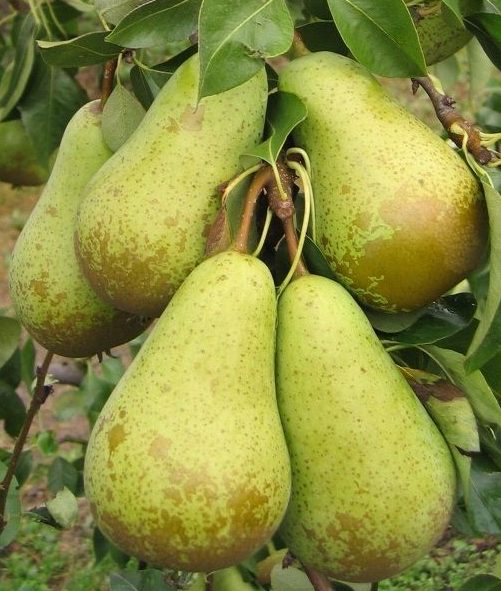

There is a noticeable difference in pruning schemes between young and old trees. In the first years of the pear's life, the correct crown is modeled. In the future, the tree is strengthened by pruning, tiers are formed, and the shape is maintained. Pruning old wood helps to rejuvenate it.
Features of pruning young pear:
- After planting the seedling for permanent residence, the first cutting of the plant is performed. A little pruning will help the plant adapt more easily and crown formation will begin.
- After a year of pear life, pruning develops its branching, skeletal branches are determined, activates the growth of fruit branches.
- The annual growth of the pear is cut by a quarter of its length every year.
- When the pear reaches the age of four, the second tier of the crown begins to form.
- Heavy pruning of young pears can affect the timing of fruiting. A tree with a weak root system and an undeveloped crown spends a lot of time and energy on recovery after a "big" pruning.
Features of pruning an old pear:
- Annual growth rates of an adult pear are cut by half or more. This procedure slows down the structure of the tree, rejuvenates it.
- It is better to prune pears in early autumn, so that the healing process is completed by the cold.
- You should be aware that rejuvenating pruning significantly reduces the fruiting of the tree.
Pest control drugs
Pests for pears are dangerous:
- Fruit moth, which destroys all fruits from the inside. Adults - butterflies - do not pose any direct danger to plants. Their main role is reproduction. The danger is borne by the young generation - caterpillars. They eat the fruit completely. The harvest is losing its value.
- Green aphid that deforms the shoots. Additionally, together with aphids, a sooty mushroom multiplies. The insect drinks all the juice from the leaves.
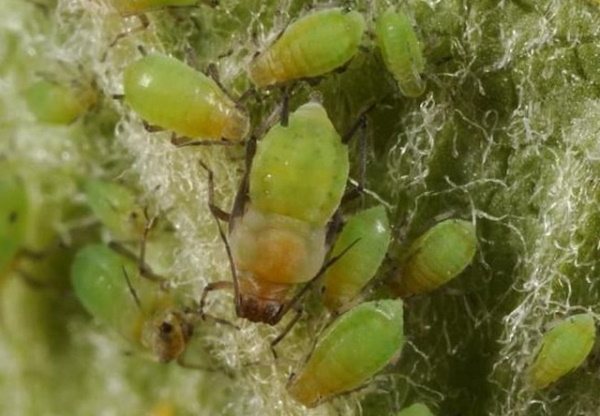

- Beetle leaf, which has a detrimental effect on the pear as a whole. The insect affects all parts of the seedling.
- A leaf roll that is small in size. The caterpillar lives in the foliage. The plates are completely rolled up into a tube. The plant loses its strength.
- Pear mite, in which the insect hides in the bark and young buds. The pest completely sucks the juice from the foliage. The normal development process of the plantation becomes impossible.
When deciding how and what is the best way to process a plant, they must take into account which pest will have to be dealt with. The plant needs to be treated with urea, which is diluted in a proportion of 0.5 kg of the product per 10 liters of water. All infected fruits and leaves must be removed and burned. To combat some pests, the use of trapping belts is sufficient. They can be purchased ready-made or made yourself.
Preventive measures to protect pears from pests, rodents and the sun
The bark and lower branches of a young tree can be damaged by rodents and insect pests. The trunk can get sunburn, which can destroy even an adult tree. To prevent this, there are a number of preventive measures:
- tie the lower part of the trunk with spruce branches, placing the branches down with thorns, fasten them tightly;
- wrapping pear trunks with a thin metal mesh, protect the tree from damage by large rodents - hares;
- whitewash the trunks and bases of the skeletal branches of the first tier of fruit trees.
Whitewashing will effectively protect the tree from sunburn and pests. You can buy ready-made whitewash in the store or prepare it yourself. To do this, dissolve one and a half kilograms of clay and two kilograms of slaked lime in ten liters of water. It is convenient to apply the solution to the barrel with a wide paint brush.
Objectives of the procedure
Pear is a fruit tree. Like other fruit plants, the planting needs regular maintenance. Autumn processing of pears is required. Pest insects love fruit plants. They can attack both the tree itself and the resulting crop. Pests can be found on foliage, bark folds, buds, or flower buds. When fruits ripen, pests are found there as well. This leads to complete or partial loss of yield. When infested, pears fall off before ripening. Carrion becomes a source of infection for healthy plants.
Pests also affect the general condition of the plant. Leaves dry up and fall off ahead of time. It should also not be forgotten that some insects act as carriers of diseases. When an infection is attached, there is a risk that the tree will die.
Spraying from pests in the fall helps to neutralize insects that have gone into the ground for wintering. It is this procedure that reduces the risk of diseases and insects. Additionally, this measure provides resistance to frost. The plant is protected from the negative effects of external factors. Spraying correctly will completely destroy all pests. In the next season, it will be possible to get the maximum possible amount of harvest.
Autumn pear watering, mulching and loosening
Cleaning the garden area, cleaning near-trunk circles, pruning - this is the preparation of a pear for an important agrotechnical event - water-charging irrigation. What is this procedure?
Trunk circles are carefully dug up and spilled. It is necessary to pour at least 40-50 liters of water under each tree. Spilled tree trunks are covered with a layer of mulch to a height of 20 cm. Such work should be planned for September or early October.
Autumn loosening and mulching of tree trunks will save the root system from mechanical damage. The soil, compacted under the weight of the snow cover, can exert a destructive load on the roots. Mulch will help preserve root moisture, protect the underground part of the plant from sudden temperature fluctuations and provide oxygen access to the roots of the wintering plant.
Such actions will help the tree to survive pruning more easily, complete the autumn metabolic processes, prepare and successfully spend the cold winter.
Pear planting rules
The roots of the prepared pear seedling are spread over a hill of soil mixture (in the pit) and sprinkled with earth. The stem of the seedling is shaken or slightly trampled in the pit so that there are no air voids. Having covered 2/3 of the hole, a bucket of settled water is poured (so that it is not too cold). After absorbing water, continue filling the planting pit to the top. Be sure to monitor that the root collar of the pear seedling is 3-4-5 cm higher than the soil. The root collar is located above the first roots and differs in the color of the bark on the stem.
The transition from the greenish bark of the trunk to the light brownish roots is the location of the root collar.
If the pear seedling is grafted, then the grafting site is above the root collar (for beginner gardeners). Having finished planting, the soil is lightly tamped with hands, a 3-5 cm high roller is prepared in a circle with a diameter of 40-50 cm, where another 1-2 buckets of water are poured. After soaking, the soil around the trunk is mulched, not reaching the central shoot 8-10 cm. At the end of planting work, a young pear seedling is tied to a support through a figure of eight. The entire warm period of autumn or, with spring planting, the entire growing season, the soil is mulched after watering. Mulch should not envelop the trunk of the pear: rotting of the young trunk may begin.
How and how to cover a pear for the winter
For these purposes, in addition to the usual plastic film, the market offers a large selection of covering material. Spantex, agryl, agrosuf, spunbond, lutrasil are trade names for insulation that gardeners use as a wrapping and covering material. Non-woven canvases, consisting of polypropylene fibers, are sold by the meter. Soft, loose, pliable material - a convenient shelter for plants, a means of protection and insulation.
The trunk and the lower part of the skeletal branches of the first tier are wrapped with prepared material and not tightly tied with strong twine. It is advisable to wrap young plants in 3 - 4 layers. It is good to hang spruce branches on top of the "wrapper". It should also be well strengthened so that the wind does not rip off the protection, and rodents cannot easily reach the trunk and branches of the pear.
It is good practice to scoop up snow to the base of the trunk during the winter - this prevents the roots of the pear from freezing. Snow can be raked down to the lower skeletal branches. During the spring thaws, avoid the formation of an ice crust at the base of the wintering pear. Ice prevents aeration of the root system, it must be broken periodically.
To grow a healthy tree and get good yields, it is not enough just to plant it and water it periodically. You need to know how to care for a pear in the fall, how to prepare it for winter, what activities will help keep the plant healthy and full for many years.
Methods of using drugs
You need to know how to process a pear in the fall. There are many nuances to consider. Copper sulfate can react with iron. Do not use metal containers for processing. Protective clothing is also worn before the procedure. The drug should not come into contact with open areas of the body.
You need to know that the method of introducing the drug is:
- root;
- foliar.
In the first case, the drug is poured into the root circle, and in the second, it is used for spraying.
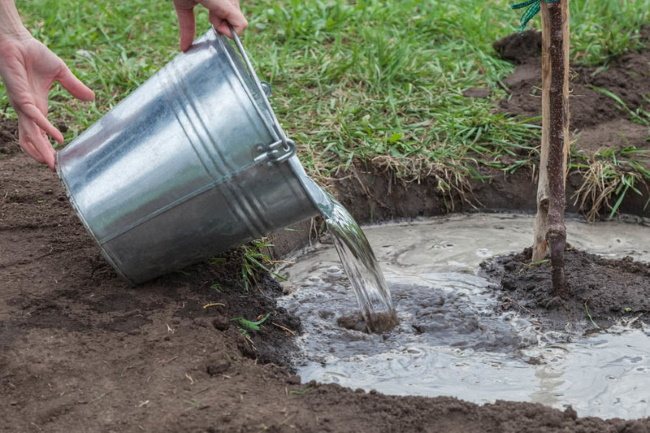

Pear is an undemanding plant. The main thing is to notice deviations in time and carry out processing in a timely manner.
Autumn preventive treatment
In order not to think about how to treat the pear from diseases and parasites, when they appear, it is best to carry out spring and autumn preventive measures.
With the onset of autumn, when the entire harvest from the front garden will be removed, it is worth taking care of the protection of fruit trees. To do this, the following measures must be taken:
- The first stage includes cleaning the area, weeding and collecting fallen leaves. All this is taken out of the area and burned.
- Then, it's time to clean the wood with a wooden scraper. It is important to completely remove the old cracked bark and any growths in the form of moss and lichen.
- Further, to make sanitary pruning and putty on the cut with a clay chatterbox or garden pitch.
After all the stages of the preparatory work have been completed, you need to spray the tree. For these purposes, copper sulfate is suitable.


Then, the treated pear trunk must be whitewashed with slaked lime. Such an additional measure will help to avoid the settlement of pests under the bark and will make it possible for the tree to overwinter well.
In addition, it is also necessary to process the near-stem zone of the pear. To do this, you need to purchase urea, dilute it according to the instructions and thoroughly water the entire area around the tree.
Urea helps to destroy all pest larvae and fungal spores that winter in the soil.
Cut and clean the crown
- The crown of the pear has characteristic features. A young plant is most often characterized by rather sharp angles of retreat of branches relative to the main conductor, especially in its upper part.
- The crown has a very powerful main trunk, and as for the ability to form shoots, it ranges from medium to low.
- We organize the crown according to a sparse-tiered system, it is this system that is closest to the natural shape of the crown.
After disembarking, we cut off the main guide, we get rid of the competitive escape. Long enough skeletal branches are made shorter by 1/3.
Preparation of planting holes
2-3 weeks before planting, the land is dug up on the site, freed from weeds, planting holes are prepared.
Pits are dug half a meter deep and 1 meter in diameter. The walls of the pit should not be smooth; notches are made on them. The upper layer is mixed with organic matter. Compost works well as it will not only fertilize but also loosen the soil. If the land on the site is prepared in advance, then the roots of the seedling are sprinkled with a removed fertile layer.
Gardeners practice the following scheme for filling pits: the bottom is filled with humus, a layer of sand is added, superphosphate, potassium sulfate are added.
To avoid shading, the distance between the holes should be equal to the height of the mature tree.
Do not bury the roots. The neck of the tree should be 5 cm above the ground.
It is easier to do the landing together. To keep the trunk perpendicular to the ground, the assistant must keep the seedling as level as possible during burial.
Near the center of the pit, a stake is dug in, to which a pear is tied. After burying, watering and mulching with peat, manure, sawdust is carried out. For better moisture retention, a hole is made along the edge of the periosteal circle.
The most favorable conditions for planting are in September or October. At the end of April, before the beginning of the growing season, seedlings are often planted in the northern regions. By winter, the culture has time to take root, gain strength. It is better to prepare the pits in the fall, so that the soil settles, compacted.
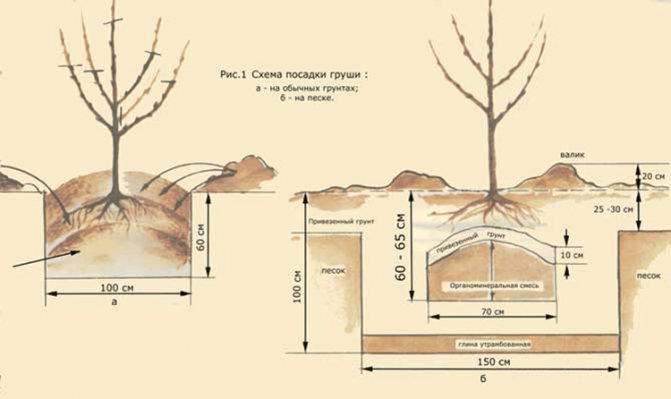

When to plant pears in autumn


In order for the planted pear to have time to take root and gain a foothold in the ground, as well as prepare for the coming winter, it is necessary to choose the correct planting dates. In general, the culture is planted no later than 2 ... 3 weeks before the onset of the first frost. More exact dates depend on the climatic zone in which the summer cottage is located, and on the recommendations of the lunar calendar of the gardener and the gardener.
In outskirts of Moscow
In the conditions of the Moscow region, depending on the weather forecast, pear planting can begin at the end of September. Planting work is completed in mid-late October. In the time remaining before the arrival of the first frost, the fruit trees have time to properly root in the ground.
In the Urals, in Siberia
In these cold regions, the autumn planting of a pear is most justified, since if it takes root and endures its first winter on the site without losses, then an adult tree will have increased winter hardiness. In the Urals and Siberia, pears are planted from early September to early October due to the short autumn and fast-onset frosts.
In the Leningrad region
The Leningrad Region is characterized by unpredictable climatic conditions, so it is important to closely monitor the weather forecast in the region. Pears are planted at the end of September - mid-October, and it is necessary to provide protection from cold through winds.
Lunar calendar
If, when planting fruit trees, take into account the recommendations of the lunar calendar of the gardener and gardener, then you need to pay attention to the most favorable days for work, and also take into account the prohibited days on which it is not recommended to plant anything. Favorable days for planting pears in 2019 fall on:
- 1, 5 ... 6, 18 ... 19, 27 ... 30 September;
- October 2 ... 3, 25 ... 26.
- Full Moon - September 25, October 24;
- New Moon - September 9, October 9.
Experienced gardeners, when planting any crops, are guided by both weather reports and the instructions of the lunar calendar and choose the most suitable date.
Typical mistakes
Novice gardeners often make mistakes during the preparation of a pear for winter. The most common of them is that they choose the wrong way of warming the plant, which often leads to its death. That is why it is recommended to take into account the climate in which the crop is grown without fail.
Some people leave the pruning process for the spring. But it's not right. In the fall, it is imperative to prune pears and remove dry and diseased branches. Cropping is also carried out to form the crown. If you prune a crop in the fall, it will be less traumatic for the plant and will not negatively reflect on the yield level.
Fertilizer must be applied before the pear is insulated. This will allow the plant to fully survive even the most severe frosts. For this purpose, the use of superphosphate or potassium phosphate is recommended. Fertilization is carried out while digging the trunk circle. You can also make a moat around the tree, the depth of which is 40 centimeters, and fertilize it. And you can also lay humus in the moat. The procedure is carried out in late autumn, so that nutrients reach the roots only in spring.
The fruit of the tree is very nutritious and many people want to grow it in their garden. In order to preserve the fertility of the culture, it is necessary to properly care for it in the autumn, as well as properly prepare it for wintering.
Even novice gardeners can do the care, pruning and sheltering of pears in the fall. The main thing is to follow the recommendations.
Gardeners consider the pear to be a whimsical tree, so it must be carefully prepared for winter, with the utmost care and patience. For such an attitude towards herself, she will definitely reward with a good harvest in the coming warm season. The preparation of this fruit tree for winter consists of several main stages.
The pear tree is often planted in summer cottages, gardens, because its fruits are tasty and healthy. In addition, the beautiful flowering of the pear cannot be confused with any other. Pear trees can grow up to fifteen meters high and begin bearing fruit in the seventh year after planting. Juicy, tasty, sweet pears are useful to eat raw, but you can make marmalade, jam, juices, compotes, add to baked goods.
Covering the tree trunk
The trunk of the tree must be wrapped with roofing felt or similar protective material. This will protect it from the cold and prevent damage to the bark by rodents, who like to feast on delicate wood and young bark in winter.
Do not forget also about the need to cover young trees and seedlings with spruce branches and spruce branches, which will protect the planting from the cold. But it is no longer required to cover adult trees with spruce branches and heat insulators.
Read also: Eggplant Mushroom Taste: description, photos, reviews
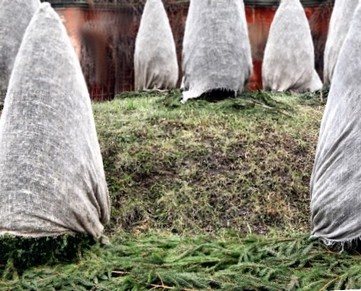

In the event that extreme frosts are expected, then the shelter of the pear for the winter is carried out especially carefully. After the first snow falls, it is recommended to make an appropriate dumping out of it, completely covering the young tree covered with spruce branches with snow.
In Siberia and in the Far North, various improvised mini greenhouses are used, when the trunk is wrapped with heat-insulating material and covered with polyethylene or roofing material on top. This is necessary if the temperature in winter is expected to be below minus 30 degrees.
How to plant a tree correctly
To grow a pear, you need to pay special attention to planting the culture in the garden. The planting time, the quality of the planting material, the condition of the soil on the site will also be important.
Landing dates
Both spring and autumn are suitable for the procedure. In April, as soon as the snow melts, you can plant pears in the holes prepared in the fall. It is important that sap flow does not begin at this time, the buds are not preparing to bloom. Autumn planting will be successful until October 10 in areas with an early onset of winter. If the seedlings are purchased later, then they are dropped into a groove half a meter deep. Roots are especially well covered. Protect seedlings from frost and damage by rodents, covering them with brushwood or non-woven material on top. They are planted in the spring.
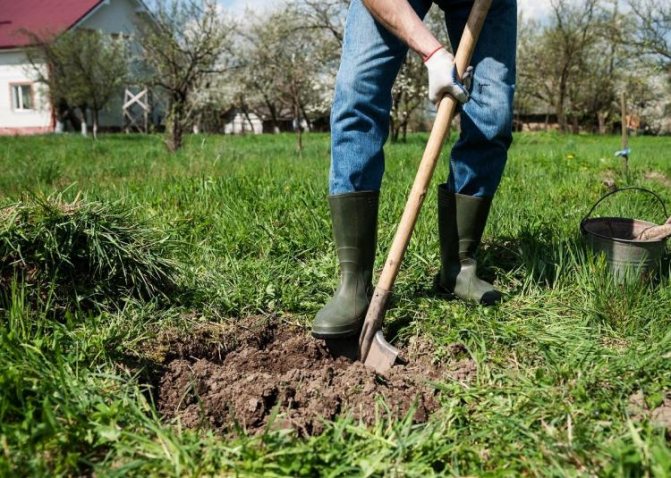

You can plant a pear in the summer, but with a closed root system, when the soil is preserved on the roots. The pear is in a container and spills well. They choose such days for planting in July, when it is cloudy and not hot.
Selection and preparation of a seedling
Seedlings are suitable for growing, which should have moist, without damage to the roots, an elastic trunk without flaws. Annual shoots can have 1-2 lateral shoots up to 12 centimeters long. It is necessary to choose biennial seedlings with branches up to 30 centimeters and roots of the same length. Before planting, slightly dried roots are dipped in water. You can nourish the roots in a solution of honey, infusion of mullein... Need pruning of rotten and damaged roots.


If you need to transplant a plant from a container, then be sure to moisturize the soil well. The shoot is pulled out of the pot carefully, trying not to damage the clod of earth on the roots.
Choosing a landing site
In addition to good lighting and evenness of the area for pears, it is necessary to allocate enough space for the tree. The accumulation of groundwater and shading of the plant will lead to the fact that it will not develop and bear fruit well.
The culture loves nutritious soil, loose, permeable, with neutral acidity.
Planting pit preparation
Dig holes for seedlings in advance, 2-3 weeks in advance, in the fall with a spring planting. The upper fertile layer is folded to one side, and the lower to the other. It is then scattered into the aisles without using it when planting. The bottom is loosened, and then the place for driving the planting stake is determined. The optimal pit dimensions will be 50-70 centimeters deep and 75-100 wide.
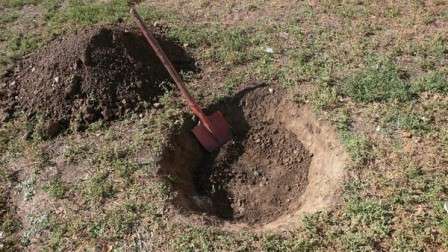

Immediately before planting the pear in the open ground, mix 2-3 buckets of humus, 200-300 grams of mineral fertilizers with a nutrient layer and fill the pit by 3 quarters. On acidic soils, add 200 grams of slaked lime. Then a bucket of humus is poured to prepare a mound for planting a plant.
Distance between seedlings
It is necessary to break up the area for pears taking into account what gap to leave between the trees. It is better to plant in rows with a distance of 4 to 5 meters, the seedlings are also separated from each other. After all, the young garden will grow, and the trees will need plenty of light, nutrition and moisture.
Landing scheme
According to the step-by-step instructions, planting begins by placing the seedling in the hole, determining the position of the root collar. It is necessary to plant the plant so that the neck is 1-2 centimeters above the surface of the loose soil. In dense soil - at surface level. After that, they begin to fill the hole with earth, straightening the roots of the trees along the mound at the bottom. When planting, the seedling is constantly shaken so that the clods of earth are distributed between the roots.


Then, around the tree, the soil is pressed down with the movements of the sole from the edge of the hole to the trunk of the tree.It is necessary to make a roller around the seedling to mark the boundaries of the hole. Moisten the soil with water from a watering can, evenly distributing moisture. One hole takes up to 3-5 buckets of water. It is necessary to plant fruit crops on a cloudy day or in the evening.
Harvesting and storage
Pears are harvested when they reach technical maturity. It depends on the ripening period of the fruit. Often, pear trees do not begin to give yields immediately after planting. You need to know what year the variety bears fruit in order to wait for the harvest. Winter varieties of culture are laid for storage. The fruits are sorted, removing rotten and damaged ones. They can be used for blanks. The rest of the fruits are laid out in boxes, which are placed in basements and cellars, where the air temperature will be within + 1 ... -2 degrees. Fruit bearing of pears will decrease every year.
Therefore, it is necessary to choose for planting those crops that are known from how many years they will give rich harvests and what is the duration of their life.
Additional food
We give top dressing to the tree within the limits of the trunk circle. During the growing season, it needs to be fed 3-4 times.
- The first feeding is carried out in the spring period at the very end of April - early May. To do this, taking 300-400 g of urea or 4-5 buckets of humus, scatter around the tree that gives us fruits.
- The second top dressing is the start of flowering. In the presence of dry weather with no precipitation, we use it in liquid form, preparing the composition as follows. We need a 200 liter barrel. We send 250-300 g of superphosphate, 200 g of potassium sulfate, slurry about 10 liters or 5 liters of liquid poultry manure to it.
It is clear that not everyone possesses slurry and bird droppings, so you can safely replace 500 g of azophoska (nitroammofoska). Stir thoroughly. On average, we spend 30-40 liters per one fruit tree, so a 200 liter barrel is quite enough for 4-5 units of plants.
Before feeding, we first spill the earth with water, then we feed it, and finish it again with water. In this case, the feeding action will be more productive.
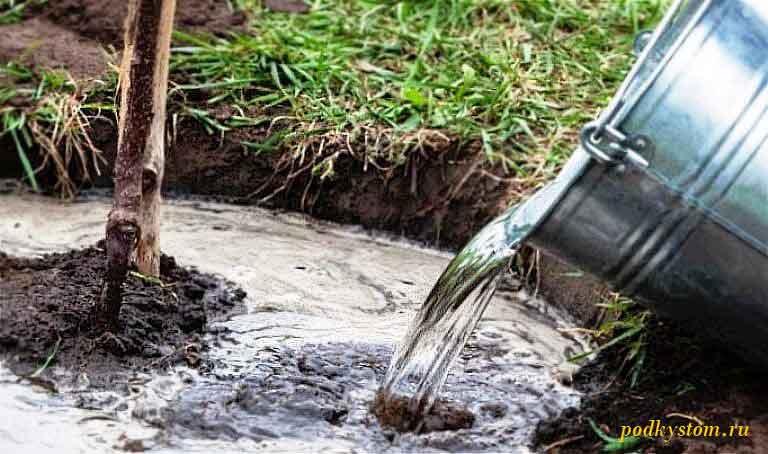

To replace slurry and poultry droppings, a liquid con (2-3 l bottle) or "Universal PoSsa" (2 l) is also suitable. We also use everything on 200 liters of water, again spending 30-40 liters per crop unit.
- The third is connected with the period of filling - 200 l of liquid - 500 g of nitrophoska with 300 g of Kemira-Lux mineral water.
- The fourth (final) one already at the end of the harvest. Sprinkle 300 g of potassium sulfate with superphosphate under a tree in wet weather with rains, and dissolve in liquid beforehand when dry.
A good effect can be obtained from foliar nutrition, especially with the help of growth stimulants. They increase the resistance of the crop to the appearance of diseases, drought, freezing. They allow you to get an earlier onset of vision of the fruits, increase their yield, as well as the quality.
What are these drugs? These are 2 capsules "Energen" and 10 g "Bud", dissolved in 10 liters. We spray it alternately from flowering to ripening, with an interval of 12 days between treatments. We process the tree, wetting well, in addition to its leaves, all skeletal branches, as well as the main trunk.
In addition, we organize two foliar dressings with an interval of 1.5 weeks using microelements that are part of complex mineral fertilizers, for example, "Kemira-Lux" (a tablespoon - 10 liters).
It is good to use wood ash containing not only potassium, phosphorus, calcium, but also the necessary trace elements. To do this, gradually fill in two glasses of ash with hot water, bringing it to the volume of a 10-liter bucket. Having strained, we proceed to spraying.
Frost breakers
After a cold winter, so-called frost holes can appear on pears. These are small areas on the main stem that are affected by the cold, resulting in malnutrition for the entire tree.
To restore the pear, it is necessary to remove the damaged bark and part of the wood, and with extensive frost holes, grafting is also performed with a bridge.
They subsequently quickly overgrow, and the growth of the tree with its fruiting indicators is restored. To prevent the appearance of frost cracks, it is necessary to whitewash trees with lime and other similar materials in late autumn or early spring.
It should be said that there may be several reasons why the tree froze. Moreover, freezing occurs not only in winter, but also in early spring, when the pear wakes up from sleep, buds and the first leaves appear on the tree.
It was during this period that night frosts pose a great danger, which can destroy the tree. It is also not uncommon for pears to freeze during cold and snowless winters.
In this case, the gardener needs to timely identify the existing problems, and carry out the grafting with a bridge, and all existing damage should be covered with garden varnish or natural oil paint.
Pear soil requirements
The pear can grow on slightly acidic, and northern varieties even on acidic soils. Reacts poorly to alkaline soil. With a lack of iron, zinc, boron, manganese, zinc, frost resistance is lost. Chlorosis is possible.
The culture does not like excess sand, and swampy, clayey soils and peat bogs can lead to death.
Sod-podzolic loams are suitable for seedlings. The soil should be fairly loose and moist. Grows well on light forest soils.


The plot is being prepared in the fall. Fertilizers are applied depending on the type of land.
For 1 sq. m of podzolic loam is added up to 60 g of superphosphate, 6 kg of organic matter, 15 g of potassium.
Sod-podzolic soil is fertilized with compost, superphosphate, potassium. Liming can be carried out.
Sandy soil is diluted with clay, humus.
If the soil is clayey, then there is no point in improving it. Over time, the root system will grow and fall into the clay layer. Such places are unsuitable for landing.
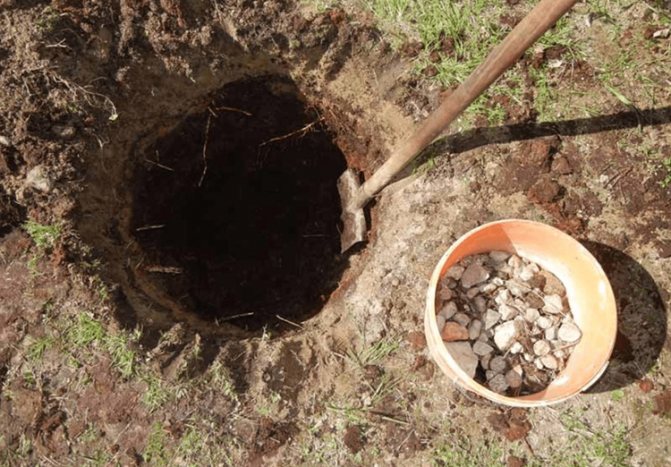

Directly disembarking
Immediately before planting, we spill the area with a composition of 3 tablets (capsules) of the "Kornerost" stimulator - 10 liters.
- We drive a peg into the prepared hole. It should not protrude above the surface more than half a meter. We also add the nutrient composition of the soil to form a mound.
Next, we proceed to disembark.
- We straighten the roots of the seedling, evenly distribute it over the mound, then carefully sprinkle it with simple soil, that is, without any fertilizers.
- When planting a seedling, we slightly shake it several times, thereby achieving filling all the voids between the roots.
At the end, we carefully trample the ground with our feet, spill it. Finally, mulch with humus (dry) in a thin layer to keep moisture in the soil.
I draw your attention to the fact that the root collar after planting remains 5-6 cm above the soil level.
When is it better to plant pears - in spring or autumn
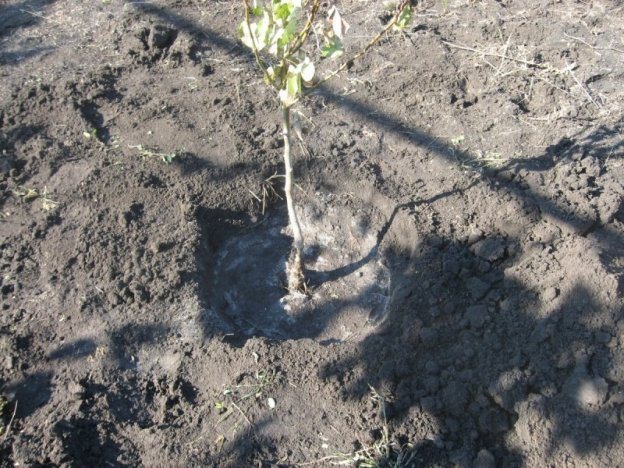

The optimal time for planting pears in Russian garden plots is in the fall. In the spring, you can also do planting work, but the survival rate and growth rate of the seedling will significantly decrease. There are a number of reasons why the autumn planting of pears is considered more preferable:
- during the dormant period, all the forces of this fruit tree are aimed at building up the root mass, so in the spring it will start to grow without any stops in development. It has been proven that pear seedlings planted in autumn are 3 weeks ahead of specimens planted in spring;
- increasing the winter hardiness of the tree;
- the soil and air are well warmed up, so the rooting period passes quickly;
- the quality of the seedlings sold in autumn is high: the root system is well developed, the grafting (if any) has already grown together;
- the price of pear seedlings in autumn is several times lower than in spring.
We select a place
Open, warmed by the sun, without stagnation of air near the tree - just the very place necessary for its growth. But one must also bear in mind that many varieties like to be sheltered from the wind.After all, not the wet, warm winds of the spring are able to burn its flowers, and in the summer they can throw off the fruits from the culture.
Unimportant health is caused by areas where the air is filled with water vapor.
The soil must be selected with a large amount of nutrients. Lowlands with a high occurrence of groundwater are contraindicated.
It will thank you for an excellent harvest if you plant it on a soil with good water and air circulation, but on the other hand, capable of retaining moisture, especially in the root layer. Will not refuse the presence of a small amount of clay, as well as lime.
To summarize the above - we are looking for a not damp, even, sun-kissed place with a well-prepared nutritious soil mixture.
We apply fertilizer and mulch the trunk circle
Appropriate fertilization under the pear will allow the tree to receive all the nutrition it needs, and, therefore, it will be able to tolerate the cold well. This means that it will continue to grow well and bear fruit well.
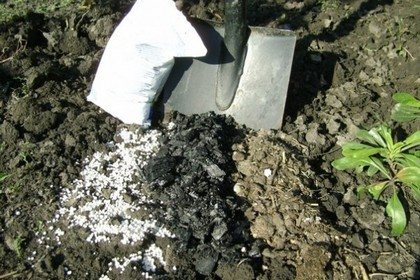

In late autumn, experienced gardeners recommend bringing rotted organic matter under the pear and watering the tree abundantly. Excellent results are also shown by the introduction of the appropriate mineral complexes, which are designed specifically for pome crops.
We can recommend that you use potassium sulfate, superphosphate, urea solution and phosphorus fertilizers for such work.
How to properly prepare fruit trees for winter (video)
Rate this post
Caring for an apple and pear in the fall also consists of spraying the branches, trunk and soil around the trunk with preparations.
For example, you can spray with a solution of copper sulfate.
Below you will find information on preparing a crop for wintering, features of care, pruning, shelter, and a diagram of how to properly prune a pear in the fall.
- 3.1 How to cover a pear for the winter
- 4.1 In the middle lane (in the suburbs)
You should know it
Before you get a pear, you need to understand what she likes and what she doesn't like.
The pear is more light-requiring than the apple tree. Mature trees do not tolerate shading; in dense plantings, they stretch strongly upward, and the fruiting zone becomes inaccessible for harvesting.
The pear has a deeper root system compared to the apple tree, so it should be planted in places where groundwater is not close.
The pear is more thermophilic than the apple tree. Therefore, a cozy place is chosen for it. Warm slopes, where the air does not stagnate, work well. Lowlands and closed hollows, where the cold "gets stuck" for a long time in winter and spring, are unsuitable.
Trees are placed 3 m from other plants so that tall trees do not obscure lower ones.
It is not necessary to compact young pears with berry bushes: trees develop weaker, and berry trees bear fruit worse. The aisles of a young garden (up to 7 years old) can be occupied with vegetables and strawberries, but not with potatoes.
Insulate the trunk circle
Young trees, whose root system is located directly at the surface, are most dangerous for the coming winter. It is necessary for young seedlings to insulate the trunk circle with organic matter. To do this, you can use sawdust, peat, humus or other similar materials.
The mulch layer is usually 3-5 centimeters. In the subsequent spring, the mulch is removed, and the earth in the near-trunk circle is slightly loosened, this will ensure the supply of oxygen necessary for the roots. Subsequently, in adult trees, mulching the trunk circle is not required.
